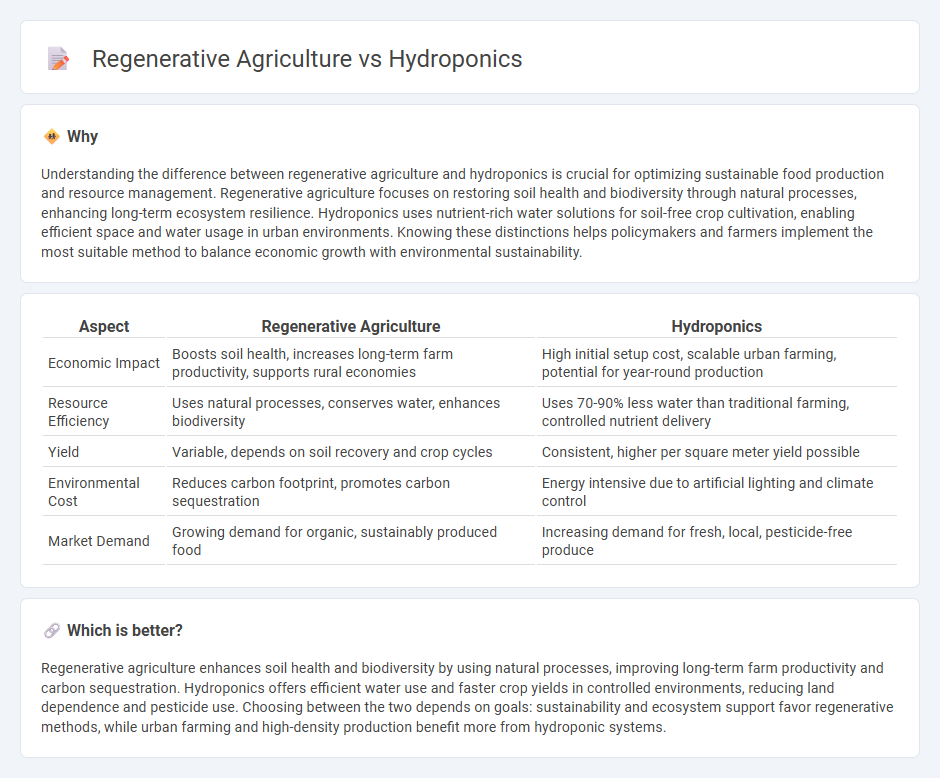
Regenerative agriculture enhances soil health and biodiversity through natural processes, promoting long-term sustainability and carbon sequestration. Hydroponics offers a soil-less method of growing crops with precise nutrient control, enabling higher yields and efficient water usage in limited spaces. Discover more about how these innovative farming systems shape the future of sustainable agriculture.
Why it is important
Understanding the difference between regenerative agriculture and hydroponics is crucial for optimizing sustainable food production and resource management. Regenerative agriculture focuses on restoring soil health and biodiversity through natural processes, enhancing long-term ecosystem resilience. Hydroponics uses nutrient-rich water solutions for soil-free crop cultivation, enabling efficient space and water usage in urban environments. Knowing these distinctions helps policymakers and farmers implement the most suitable method to balance economic growth with environmental sustainability.
Comparison Table
| Aspect | Regenerative Agriculture | Hydroponics |
|---|---|---|
| Economic Impact | Boosts soil health, increases long-term farm productivity, supports rural economies | High initial setup cost, scalable urban farming, potential for year-round production |
| Resource Efficiency | Uses natural processes, conserves water, enhances biodiversity | Uses 70-90% less water than traditional farming, controlled nutrient delivery |
| Yield | Variable, depends on soil recovery and crop cycles | Consistent, higher per square meter yield possible |
| Environmental Cost | Reduces carbon footprint, promotes carbon sequestration | Energy intensive due to artificial lighting and climate control |
| Market Demand | Growing demand for organic, sustainably produced food | Increasing demand for fresh, local, pesticide-free produce |
Which is better?
Regenerative agriculture enhances soil health and biodiversity by using natural processes, improving long-term farm productivity and carbon sequestration. Hydroponics offers efficient water use and faster crop yields in controlled environments, reducing land dependence and pesticide use. Choosing between the two depends on goals: sustainability and ecosystem support favor regenerative methods, while urban farming and high-density production benefit more from hydroponic systems.
Connection
Regenerative agriculture enhances soil health and carbon sequestration, creating sustainable ecosystems that can complement hydroponic systems by providing organic inputs and biodiversity support. Hydroponics offers precise control over nutrient delivery and water efficiency, reducing the environmental footprint compared to traditional farming. Together, these methods optimize resource use and promote resilient food production systems essential for a sustainable economy.
Key Terms
Input Costs
Hydroponics typically requires higher initial input costs due to investments in nutrient solutions, specialized equipment, and controlled environment systems, whereas regenerative agriculture relies more on natural inputs like cover crops and compost, reducing chemical and synthetic costs. Operational expenses in hydroponics can be significant, especially for energy consumption and maintenance, while regenerative practices benefit from improved soil health that lowers input needs over time. Explore the detailed cost comparisons and long-term economic impacts of hydroponics and regenerative agriculture for sustainable farming insights.
Yield Efficiency
Hydroponics offers significantly higher yield efficiency by delivering nutrients directly to plant roots in a controlled environment, enabling faster growth cycles and year-round production. Regenerative agriculture enhances soil health and biodiversity, improving crop resilience and long-term productivity but often with slower yield gains. Explore detailed comparisons to understand which method aligns best with your agricultural goals.
Market Value
Hydroponics market value reached approximately $16.3 billion in 2023, driven by rapid urbanization and demand for sustainable farming solutions. Regenerative agriculture, valued at around $8 billion, is gaining traction due to increasing consumer preference for eco-friendly and soil health-focused practices. Explore detailed market trends and growth projections to understand their economic impact.
Source and External Links
Hydroponics - Wikipedia - Hydroponics is a soil-less horticulture technique that grows plants in nutrient-rich water solutions, offering benefits like reduced water use, faster growth, higher yields, year-round production, pest control, and suitability for urban farming environments.
Hydroponics - National Agricultural Library - USDA - Hydroponics involves growing plants using water-based nutrient solutions with or without growing media, used by small farmers and commercial growers for crops including herbs, vegetables, and ornamentals, with resources available for system building and management.
Small-scale hydroponics | UMN Extension - Hydroponics is a versatile soilless gardening method enabling year-round plant growth indoors or outdoors, requiring a nutrient solution, container, and sometimes supplemental light, and is ideal for people with limited space growing vegetables, herbs, and fruits.
 dowidth.com
dowidth.com